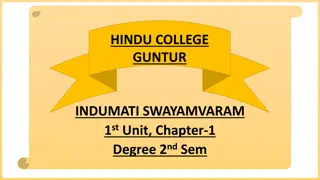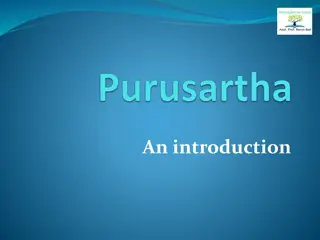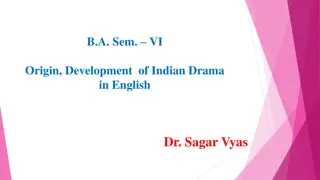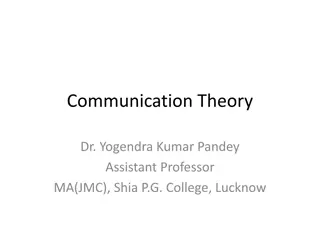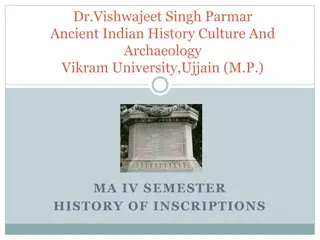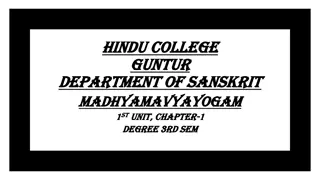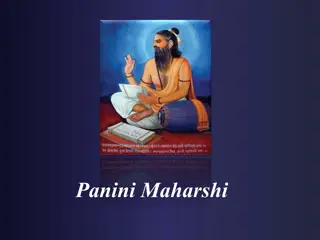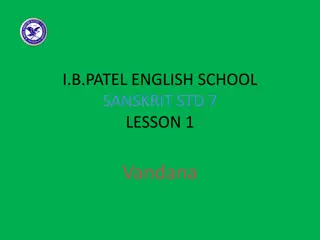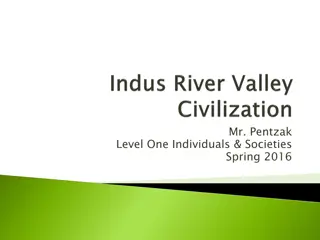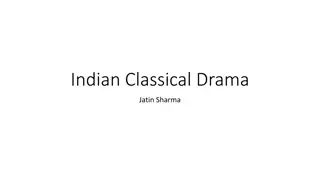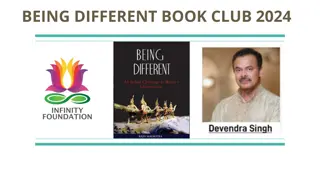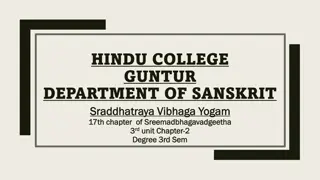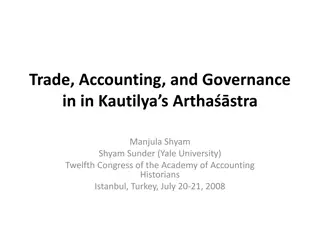Together with Best Question Bank for Class 9 CBSE 2024 Sanskrit (Shemushi) for n
Best Question Bank for Class 9 Sanskrit (Shemushi) for Session 2024-25 has been released. Question Bank for Class 9 CBSE 2024 based on latest syllabus includes Section-wise MCQs and Important Terms, Practice Questions, Practice Papers, Completely Solved NCERT Textbook Exercises and much more, Get co
0 views • 1 slides
Understanding Inference and Vyapti in Logic
Inference, known as Anumana in Sanskrit, is the process of deriving knowledge based on existing information or observations. It can be used for personal understanding or to demonstrate truths to others. An inference may be SvArtha (for oneself) or ParArtha (for others). Vyapti, the invariable concom
1 views • 14 slides
Biography and Works of Kalidasa: The Great Poet of Ancient India
Kalidasa, the revered poet of ancient India, is celebrated for his significant contributions to Sanskrit literature. Known for works like "Abhignana Sakuntalam" and "Raghuvamsam," Kalidasa's life and poetic genius continue to inspire scholars and enthusiasts alike. This biography explores his origin
5 views • 16 slides
Understanding Purusharthas: The Four Goals of Human Life
Purushartha, derived from Sanskrit, encompasses the four life goals of dharma (duty), artha (prosperity), kama (pleasure), and moksha (liberation). Dharma, the foundation, guides the pursuit of the other goals leading to spiritual fulfillment. While dharma is considered paramount, moksha is ideal, e
6 views • 17 slides
Prarthana Samaj
Prarthana Samaj, meaning "Prayer Society" in Sanskrit, was founded in 1867 by Atmaram Pandurang with the objective of promoting belief in one God and advocating worship of the same. The movement gained traction when Mahadev Govind Ranade joined, with intellectuals advocating social system reforms. I
5 views • 12 slides
Origin and Development of Indian Drama in English
Indian English Drama has a rich history, starting from the Sanskrit plays of the Vedic Age to prominent playwrights like Rabindranath Tagore and Sri Aurobindo Ghosh. The genre saw a resurgence in the 20th century with significant contributions from various playwrights marking its evolution through s
0 views • 8 slides
Indian Theories of Communication: Understanding Sadharanikaran
Indian communication theories have deep roots in religious literature and fine arts, with concepts like Sadharanikaran emphasizing mutual understanding and commonness. This Sanskrit term reflects the essence of communication as a relationship based on shared feelings and culture, rather than persuas
1 views • 8 slides
Evolution of Inscriptions in Ancient Indian History
The evolution of inscriptions in ancient India reflects a shift from Prakrit to Sanskrit languages over the centuries, marking changes in content, purpose, and classification. Beginning with Brahmi inscriptions, the transition to Sanskrit gradually replaced Prakrit as the language of choice in North
0 views • 12 slides
Introduction to the Sanskrit Drama "Madhyama Vyayoga
A Brahmin named Kesavadas and his family encounter the demoness Hidimba's son Ghatotkacha while traveling to his cousin's thread ceremony. Mistaking Ghatotkacha for the God of Death, they seek help from the Pandavas who are residing nearby. Ghatotkacha tries to assure them of no harm, but the family
0 views • 11 slides
Panini Maharshi: The Foremost Grammarian of Sanskrit Language
Panini Maharshi, the first and foremost grammarian of the Sanskrit language, is best known for his work Asthadhayai, a book on grammar which is highly revered among scholars and learners. His scholarly approach and foundational work in grammar have made him a prominent figure in linguistic studies.
4 views • 10 slides
Devotion and Learning: Vandana in Sanskrit - Lesson 1 at I.B. Patel English School
Explore the essence of devotion and learning in Sanskrit with Lesson 1 at I.B. Patel English School. Dive into prayers to Goddess Saraswati, the significance of Sanskrit as the mother language, and invoking blessings for health, wealth, and wisdom.
0 views • 10 slides
Exploring the Vedas: Ancient Sanskrit Texts and Their Divisions
Diving into the roots of knowledge, the Vedas are ancient texts derived from the root meaning 'to know'. Various synonymous terms like ruti, tray vidya, gama, and chandas are used to describe these sacred scriptures. The Vedas consist of four main divisions - Rigveda, Samaveda, Yajurveda, and Atharv
0 views • 14 slides
Ancient Civilizations Studies and Group Activities
Explore the similarities between Mesopotamia and Ancient Egypt, make predictions about another ancient civilization, engage in group activities like reading chapters, answering questions, and playing Vocab Alive. Learn about key terms like Monsoon, Sanskrit, Caste System, and more. Collaborate in sm
0 views • 33 slides
Insights into Indian Classical Drama and Literature
Explore the rich tradition of Indian classical drama and literature, from its origins in Ujjain during the Gupta period to the classification of major and minor dramas. Learn about the components of a classical Sanskrit drama, such as the plot, characters, sentiments, acting, and more. Delve into th
1 views • 9 slides
Hindu Upanayana Ceremony Explained
The Upanayana ceremony, also known as the Sacred Thread ritual, is a significant Hindu rite of passage for boys, akin to the Hindu Bar Mitzvah. It symbolizes the transition to youth and the beginning of a quest for knowledge of sacred scriptures. Over a two to three-day period, the ceremony includes
0 views • 15 slides
The Uniqueness of Sanskrit: A Cultural Journey Through Non-Translatability
Explore the depth of Sanskrit language and culture, delving into the significance of non-translatability. Discover how Sanskrit mantras hold the essence of creation and resistance against colonization, emphasizing the vibrational power within. Immerse yourself in the holistic experience of ancient w
0 views • 39 slides
Exploring Philosophy: The Love of Wisdom and Fundamental Questions
Delve into the world of philosophy with a focus on the love of wisdom. Explore the basic questions of reality, value, and knowledge. Uncover the branches of philosophy and concepts like metaphysics, epistemology, and axiology. Understand the Greek and Sanskrit roots of philosophical terms and their
0 views • 16 slides
Understanding Rasa Theory in Indian Theatrical Arts
Explore the significance of Rasa theory in Indian theatrical arts as outlined in the Natya Shastra, an ancient treatise on performing arts. Discover how bhavas create rasas, evoking emotions in the audience and transporting them to a parallel world of wonder and reflection. Learn about the historica
0 views • 18 slides
Understanding Devanagari Sanskrit Writing System
Explore the beauty and complexity of the Devanagari writing system used for Sanskrit and other Indic languages. Learn about its unique order of letters, aspirates, phonemes, and intricate vowel structures. Discover why Devanagari is a fascinating script to study and appreciate.
0 views • 8 slides
Heartwarming Appeal for Help in Sanskrit Poetic Verses
Poetic verses in Sanskrit language convey a heartfelt appeal for assistance and support. The verses express a deep yearning for aid and kindness, appealing to the emotions of the readers. The evocative language and poignant imagery enhance the emotional impact of the message, inviting empathy and un
0 views • 35 slides
The Versatile Safflower: History, Uses, and Benefits
Safflower, known as "Kusumbha" in Sanskrit literature, is a member of the Asteraceae/Compositae family. It is a minor oil seed crop rich in PUFA, benefiting blood cholesterol control and cooking. The plant has a long history, dating back thousands of years and is valued for its oil, flower extract,
0 views • 27 slides
Hindu College Guntur Department of Sanskrit - Sraddhatraya Vibhaga Yogam Introduction
The introduction provides insights into the department of Sanskrit at Hindu College Guntur, highlighting the significance of Sraddhatraya Vibhaga Yogam and the 17th chapter of the Sreemadbhagavadgeetha. It explores the role of Vyasa in Hindu traditions and his association with the Mahabharata, shedd
0 views • 10 slides
Certificate Courses in Indian Cultural Studies by Department of Vedic Sciences & Indian Culture
Explore month-long certificate courses in Indian Cultural Studies offered by the Department of Vedic Sciences & Indian Culture in collaboration with Sri Aurobindo Foundation for Indian Culture. Delve into India's rich cultural heritage to gain insights into ancient wisdom traditions, prepare for con
0 views • 8 slides
Trade, Accounting, and Governance in Kautilya's Arthashastra
Kautilya's Arthashastra, a Sanskrit treatise from the late fourth century BC, discusses the principles of trade, accounting, and governance in ancient India under the Mauryan Empire. It emphasizes the importance of proper administration, wealth management, and the prevention of corruption within the
0 views • 31 slides
Education and School Overview
Education is the ability to listen without losing temper. Navy Children School in Visakhapatnam has dedicated teachers across various subjects. The school focuses on uniformity in assessment patterns for Classes VI-IX from 2018-19 academic year. The remodelled assessment structure comprises Term 1 a
0 views • 30 slides


